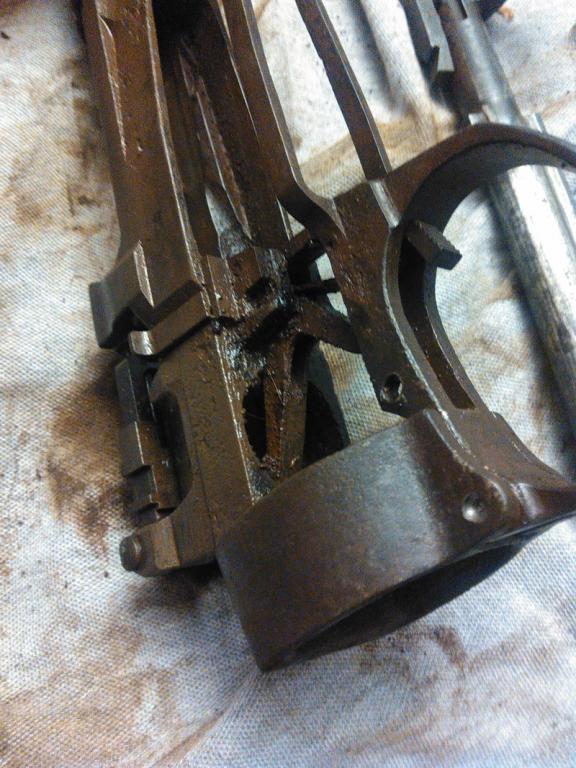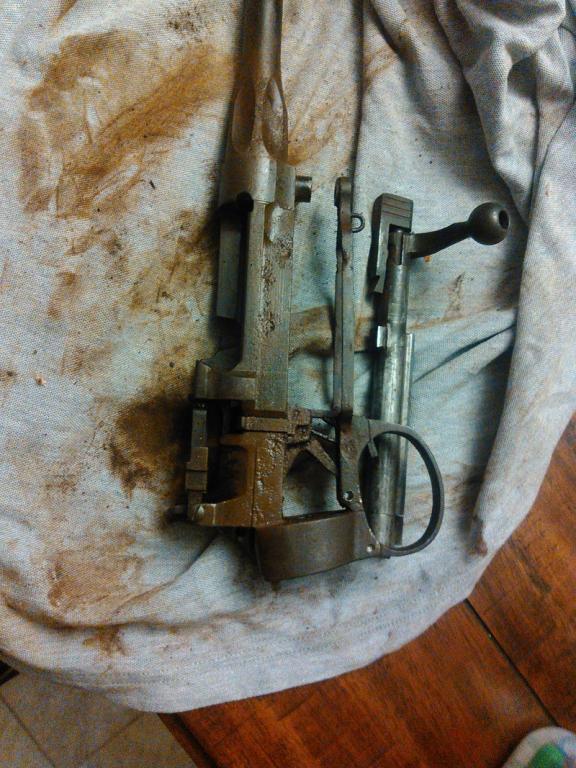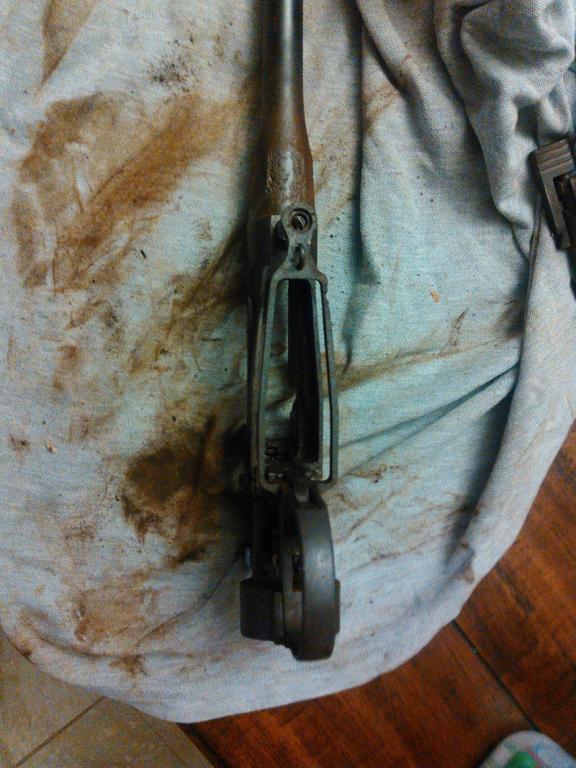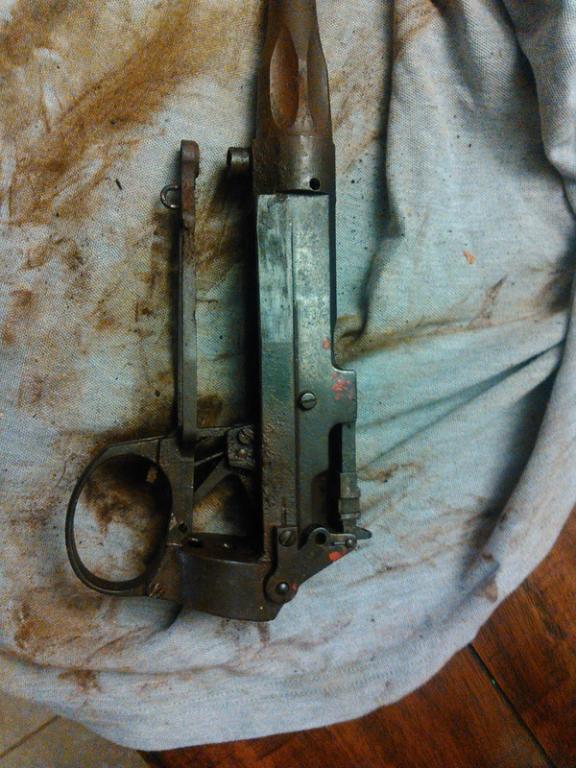-
Snip and braze is just what we used to do on an everyday basis. If the barrel was rusty then you could be sure that the bottom of the ring had gone too. But word of advice here first. DO NOT cut it with a hacksaw. Always snip across the new one with snips because this leaves the joined ring the same diameter when you braze the ends together
-
The Following 3 Members Say Thank You to Peter Laidler For This Useful Post:
-
05-24-2016 04:46 AM
# ADS
Friends and Sponsors

-
FREE MEMBER
NO Posting or PM's Allowed


Originally Posted by
Catch22

I know raw linseed oil in a heated tank is original from some past readings of Peter's, but
BLO
has been my go-to substitute.
Every Lee Enfield purist will chastise me for what I'm going to say here, but I will say it anyway: Do not use RLO -- it will be gummy, attract dirt, and oxide to a dark chocolate brown over several decades. RLO was used during war because it was plentiful and cheap. BLO is better -- it will function better, will dry better, and will take twice as long to turn chocolate brown.
is better -- it will function better, will dry better, and will take twice as long to turn chocolate brown.
As a restorer of old boats that have to bake in the hot Florida sun and withstand tropical rain conditions in the summer, I will state unequivocally that if you want the wood on your gun to receive the best treatment, you will not use BLO but instead use pure Tung Oil -- it's is a better wood preservative, a better fungicide, doesn't oxidize (thus displaying the grain better) and a more durable, waterproof finish. Tung Oil was used on M1s whenever it was available because it is better, but more expensive. The very best marine varnishes use Tung Oil as their base. The cheap (low quality, poor performing) marine varnishes use Linseed Oil as their base.
This summer I am going to do an experiment -- put a piece of wood out in the hot sun and tropical rain -- one half covered with BLO and the other half covered with Tung Oil. When the experiment is over, you can see the results for yourself (maybe you'll try it for yourself). Then decide what you want to do with your expensive cherished gun. Just my opinion.
Phone Brian at
BDL
in SC, (he's on this site) ask him to look at the photos and then ask him to give you a quote for bead blasting the steelwork, phosphating and painting. You fully strip it and carefully assemble it afterwards. It's easy!
Brian is the best. If you want to bring your gun back to the highest quality standards, you can't go wrong. He restored my Long Branch sniper -- it is as good as new -- the best Lee Enfield in my collection.
-
-
Legacy Member

Electro penciled or stamped markings generally don't just wear off.
I've seen markings removed during a refurb but they are generally replaced.
I do see a broad arrow but no other markings at all, seems strange.
There should be markings identifying it as being made by Fazakerley or BSA the only makers of No5's.
Every part of my 1945 Fazakerley has a marking or number or both on it.
I'm just hoping you didn't end up with one of those Khyber Pass knockoffs that are dangerous to shoot.
You really need to go over that rifle very very carefully with a magnifying glass to try and find any hidden markings before you put money into it.
Look for all the genuine No5 traits, fluted chamber, hollowed bolt handle, removed action lug on the right side behind chamber,
trigger guard figure 8 shaped by the front screw, hollowed out sear ect. None of your pics show any of any of these id factors. - Bill
-
-
Legacy Member


Originally Posted by
oldfoneguy

Electro penciled or stamped markings generally don't just wear off.
I've seen markings removed during a refurb but they are generally replaced.
I do see a broad arrow but no other markings at all, seems strange.
There should be markings identifying it as being made by Fazakerley or BSA the only makers of No5's.
Every part of my 1945 Fazakerley has a marking or number or both on it.
I'm just hoping you didn't end up with one of those Khyber Pass knockoffs that are dangerous to shoot.
You really need to go over that rifle very very carefully with a magnifying glass to try and find any hidden markings before you put money into it.
Look for all the genuine No5 traits, fluted chamber, hollowed bolt handle, removed action lug on the right side behind chamber,
trigger guard figure 8 shaped by the front screw, hollowed out sear ect. None of your pics show any of any of these id factors. - Bill




---------- Post added at 01:28 PM ---------- Previous post was at 01:25 PM ----------

Originally Posted by
Seaspriter

Every Lee Enfield purist will chastise me for what I'm going to say here, but I will say it anyway: Do not use RLO -- it will be gummy, attract dirt, and oxide to a dark chocolate brown over several decades. RLO was used during war because it was plentiful and cheap.
BLO
is better -- it will function better, will dry better, and will take twice as long to turn chocolate brown.
As a restorer of old boats that have to bake in the hot Florida sun and withstand tropical rain conditions in the summer, I will state unequivocally that if you want the wood on your gun to receive the best treatment, you will not use
BLO
but instead use pure Tung Oil -- it's is a better wood preservative, a better fungicide, doesn't oxidize (thus displaying the grain better) and a more durable, waterproof finish. Tung Oil was used on M1s whenever it was available because it is better, but more expensive. The very best marine varnishes use Tung Oil as their base. The cheap (low quality, poor performing) marine varnishes use Linseed Oil as their base.
This summer I am going to do an experiment -- put a piece of wood out in the hot sun and tropical rain -- one half covered with BLO and the other half covered with Tung Oil. When the experiment is over, you can see the results for yourself (maybe you'll try it for yourself). Then decide what you want to do with your expensive cherished gun. Just my opinion.
Brian is the best. If you want to bring your gun back to the highest quality standards, you can't go wrong. He restored my Long Branch sniper -- it is as good as new -- the best Lee Enfield in my collection.
I actually have some Tung Oil and considered it. Or even putting a few coats on top of the BLO. I've got an old Swiss 1889 sporter I need to dress up I've considered it using on as a test. I've used the Tung on a couple 22's and it flat made the grain pop.
1889 sporter I need to dress up I've considered it using on as a test. I've used the Tung on a couple 22's and it flat made the grain pop.
-
-
Hear what you're saying oldfone (thread 23) but Fazakerley markings, done with what we called 'the scratchy pen' (or electric pencil mounted in a pantograph frame) were notorious for wearing off. Once in the bead blasting booth, they'd be off in seconds. We didn't bother ourselves with replacing manufacturing or designation detail. But we always replaced missing or obliterated numbers.
Regarding wood treatment. We knew all about extreme zapping heat, monsoon rains for most of the year, salt water, mangrove silt and beating sunshine in Malaya as it affected our rifles and machine guns so am at a loss to understand why we didn't use tung oil or any of the other super-dooper concoctions. All our woodwork was dunked in a constant warm-to-touch linseed oil bath for the day and left to drip dry. And that is STILL the specified treatment on our wood today - as I have just confirmed in a phone call!
bath for the day and left to drip dry. And that is STILL the specified treatment on our wood today - as I have just confirmed in a phone call!
Just seen the recent photos. That's no different to the hundreds of No4,s 5's, L1A1's and shotguns, Brens and SMG's that used to go through the Base workshop system every week
Last edited by Peter Laidler; 05-24-2016 at 02:34 PM.
-
The Following 5 Members Say Thank You to Peter Laidler For This Useful Post:
-
Legacy Member

Just saw the updated pics, yea it looks real enough to me.
Even through the rust and the dirt you can plainly see it doesn't have any of the crude hallmarks of a Khyber Pass receiver.
It doesn't look like cast flash has been slightly filed and then it was painted with a roller!
She looks like the real deal and I'll bow to Peter's expertise, but I still wonder why no numbers were replaced. - Bill
-
-
Advisory Panel


I'd say no numbers have been replaced since it hasn't been through the FTR process.
-
-
Legacy Member

I realize I'm reviving a 5 year old thread, but I'm doing so with good reason.
Shortly after starting this thread, we sold our place and moved. As a result, this project got put off. This project has been wrapped in an oily old t-shirt and only brought out here and there to make sure it wasn't rusting or the like.
I got to getting into tearing everything down to start working on it and bringing it back to life. As a result, the screw that goes through the rear of the trigger guard holding it to the bottom of the wrist had to be drilled out. Soaking for several weeks, heat, and other methods didn't get it loose and the chewed up screw head (like that when I got it, you can see in the pics) broke half of it off. Sucker was flat siezed up and took some work.
I have a small ring of old screw still in the threaded side of the wrist I'm working on figuring out how to get out without damaging the threads. However, what I can see of the threads I'm half afraid someone before me may have boogered them up a bit.
As such, I'm working my head around the next steps and wondering if I'm going to have to chase the threads when I get the ring of what's left out. Trying to make sure I've got the right threads, though. From what I'm finding, it is a British 4BA thread? So I'd be looking for a 4BA tap, if that's the case.
4BA thread? So I'd be looking for a 4BA tap, if that's the case.
-
-
Advisory Panel


You already have this going in another thread...right? Why doubt the info you already got here? Yes, British threads...
threads...
-
-
Legacy Member

You already have this going in another thread...right? Why doubt the info you already got here? Yes,
British
threads...
You mean the post in the gunsmithing forum?
Unless I've missed one, the only response I got to that question was to try in the Enfield forum. I hadn't seen a reply that had an answer.
Apologies if I duplicated.
-
















 PM
PM














